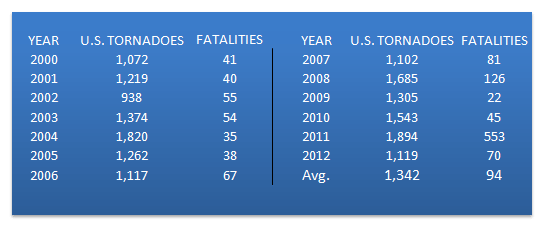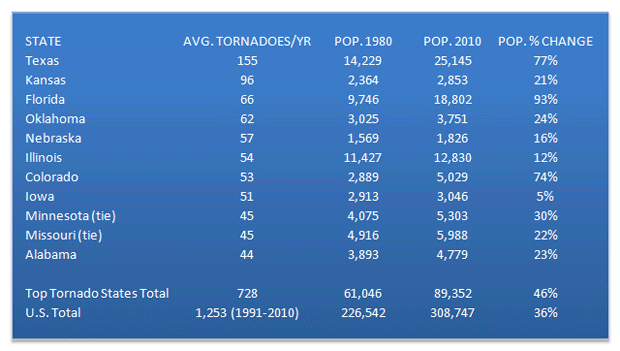By Chris Nichols | The Exchange
Were you watching The Weather Channel this week, you stood a good chance of catching meteorologists Jim Cantore and Mike Bettes as they raced to track down potentially tornado-spawning systems in Texas and Oklahoma.
The latter noted on his Twitter account Friday that May 10 marked the 17th anniversary of the opening of the movie Twister. The network's Tornado Hunt has been at full speed, with the duo joining storm chasers — sometimes employing tank-like protected vehicles such as the Dominator 3 — in a bid to intercept and document a tornado up close. The timing isn't accidental. May, on average, stands as the nation's most active month for tornadoes, with a typical count above 250. Thus far this month, through May 8, there have been only three.


Were you watching The Weather Channel this week, you stood a good chance of catching meteorologists Jim Cantore and Mike Bettes as they raced to track down potentially tornado-spawning systems in Texas and Oklahoma.
The latter noted on his Twitter account Friday that May 10 marked the 17th anniversary of the opening of the movie Twister. The network's Tornado Hunt has been at full speed, with the duo joining storm chasers — sometimes employing tank-like protected vehicles such as the Dominator 3 — in a bid to intercept and document a tornado up close. The timing isn't accidental. May, on average, stands as the nation's most active month for tornadoes, with a typical count above 250. Thus far this month, through May 8, there have been only three.
While there's little doubt these quests are exhilarating for those who take part, finding a tornado in the middle of nowhere is one thing. When these rotating storms — capable of producing winds above 200 mph at their strongest — hit homes, farms or businesses, it's quite another. That's when loss of life and property damage become very real concerns. Violent, extremely deadly varieties are rare, and that's the good news. The bad news is that the economic cost of dealing with the aftermath of tornadoes and severe thunderstorms looks to be climbing.
Planning for the expense of the storms isn't simple. For hurricanes, extensive data and decades of study have allowed insurers to make certain predictions about the impact of these ocean-borne storms. That's not the case for tornadoes.
"The risk modeling related to tornadoes is still relatively new," says Julie Rochman, president and CEO of the Insurance Institute for Business & Home Safety. "One of the problems is that the information that we have about the systems that produce tornadoes, and the tornadoes themselves, is nowhere near the type of information data we have on hurricanes. The storms come up very, very quickly, and they dissipate very, very quickly, in most cases."

Source: Storm Prediction Center.
Where they are, what they cost
So far in 2013, 237 tornadoes have been recorded in the U.S., according to the Storm Prediction Center. The nation has more tornadoes by far than any other country on earth, and they've hit all 50 states at some point, with the midsection of the country and the Southeast being the most active locations.
On average, Texas has the highest number of confirmed tornadoes annually, but that's influenced by the state being the largest geographically in the contiguous U.S. When the state's size is factored in relative to the number of tornadoes, Florida would qualify as the busiest.
Accurately attributing a dollar’s worth of damage specifically to the winds of a tornado isn't always clear cut. Some reports of insured and uninsured losses group tornadoes with the severe thunderstorms from which they come. That means harm to a given structure could be the result of powerful straight-line winds, hail, water or lightning, with perhaps a tornado itself a secondary element or none at all.
Even though data on the monetary impact of tornadoes may vary depending on the source, it's not difficult to find enormous numbers. One estimate puts the amount insurers have paid on tornado-related property claims in the past two decades at roughly $130 billion. That's according to the findings of a Verisk Analytics division, made available on the website of the Insurance Information Institute. This particular data set breaks out a separate category for wind, hail and flooding, which it pegs at $14.8 billion.
Since 1980, claims appear to be on an upward trajectory when measured using current dollars to keep the comparisons fair, based on data collected by Germany’s Munich Re insurance group. From that year through 1997, insured losses from thunderstorms in the U.S. exceeded $5 billion only twice. Starting with 1998, the country has seen 11 years in which losses were more than $5 billion. That includes the past five, all of which surpassed the $10 billion mark, according to the insurer's information and data from a unit of Verisk.
The worst of those was 2011, a year that included major tornadoes in Tuscaloosa, Ala., and Joplin, Mo., the latter of which is the most expensive tornado ever, along with being the seventh-deadliest in U.S. history, claiming 158 lives. Last year was No. 2 for losses.
Largely because of that year, "People now are looking at tornadoes, and what are called convective storms generally, in a way in the insurance industry that previously they had looked only at hurricanes," Rochman says.
For the firms in charge of coverage, this has led to a re-examination of losses and discussions about how insurers can work with policyholders on better protecting their property and businesses in the event a tornado strikes. About one in four small businesses that close for more than 24 hours after a natural disaster never reopen, she adds.
"I think the 2011 storm season was a wake-up call for a lot of insurers who weren't writing along the coast," Rochman says.
Beyond what's reimbursed by insurance, the true amount of destruction is undoubtedly higher. Consider that Munich Re estimated insured losses at just under $15 billion from tornadoes and dangerous thunderstorms in 2012, while total economic losses were projected at more than $27 billion.
England's Lloyd's insurance organization recently published a report aiming to quantify what is known about the economic impact of tornadoes, drawing on multiple inputs, including damage reports from insurers, scientific data and government information. Its conclusion, in short, was that insured losses stemming from dangerous tornadoes are growing. However, this is believed to be more a function of where people live in the modern day, rather than a sign that tornadoes and punishing thunderstorms are becoming more frequent or stronger.

Population in 000's. Data from U.S. Census Bureau, state government websites. Tornado data from National Climatic Data Center.
More people and more reports
The National Oceanic and Atmospheric Administration's National Climatic Data Center has collected tornado counts from 1950 onward. The charted findings show a clear increase in the number of reports, and it's become a near certainty that the U.S. will have more than 1,000 in an average year. In the middle of the 20th century, the number was in the 200-range. But there's a major shortcoming to drawing a quick conclusion.
"With increased national Doppler radar coverage, increasing population, and greater attention to tornado reporting, there has been an increase in the number of tornado reports over the past several decades," the NCDC says. "This can create a misleading appearance of an increasing trend in tornado frequency."
Similarly, Lloyd's says, "as densely populated suburbs which surround cities continue to grow, the chances of tornadoes hitting an urban or suburban region increases. In turn, it is likely that property damage claims for tornado damage will become more expensive as the values at risk grow."
Extremely strong or violent tornadoes, what would be classified as F3/EF3 and higher, haven't become more prevalent over the years (click for NOAA chart), further suggesting the insurance loss totals aren't being influenced by storm strength. Here again, though, the comparisons over time aren't necessarily exact. The Fujita scale was created in 1971 to measure tornadoes; it was altered in 2007 to become the Enhanced Fujita scale.
As for climate change or global warming as a possible factor, scientists have studied climate and tornadoes, but, so far, the data largely have been inconclusive and haven't established a link. (A good recap ran in The New York Times in April 2011.) Regardless, Munich Re has declared that it believes global warming does play a role in thunderstorm destructiveness, earning it criticism from some andpraise from others. It also points to the shifting locations of U.S. residents as another key component of storm costs.
For its part, Lloyd's keeps to the position that nothing has been proven on the climate side. Still, in terms of expense, it is concerned about the insurance industry. Considering it seems likely people will continue inhabiting the countryside, chipping away at the unpopulated lands, that's not unreasonable.
"An active tornado season hitting populated areas could result in high damages, and it is important that insurers consider [modeling] and managing potential exposure," Lloyd's says.
Rochman notes one of the goals in the industry is to reduce the amount of damage by making commercial structures and homes less brittle. As a result, she wonders if a debate might emerge in the future about whether storms are becoming less potent.
"And the answer will be no — we hardened the building stock," she says. "We're seeing less damage because the buildings are staying together better."
please give me comments thanks

 8:50 PM
8:50 PM
 admin
admin




0 comments:
Post a Comment